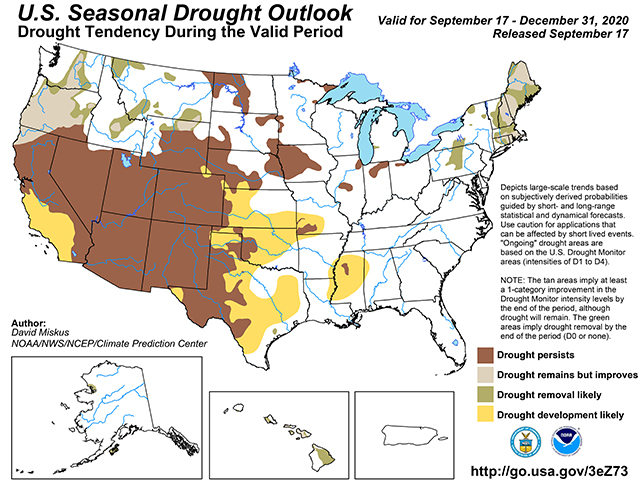Weatherlink
Dry Soils for 2021?
For many crop areas, the fall of 2020 is ending with a concern about possible dry soils for the start of the 2021 crop year. We saw a turn from very wet to very dry conditions in much of the central U.S. during 2020, and the outlook calls for drought to expand from the western Plains eastward to the Delta over the balance of this calendar year and into the winter.
In addition, no letup in drought is likely in the western Midwest or portions of the Northern Plains. Overall, drought experts note that central-U.S. drought conditions are the highest in more than five years, going back to 2013.
At press time, forecasts through the rest of calendar-year 2020 have a strong signal for below-normal precipitation in the Southern Plains and Delta. This drier trend leads to a forecast for drought to cover this entire segment of the contiguous U.S. At the same time, drought-affected areas in the Midwest have equal chances for above-normal, normal or below-normal precipitation leading to a prediction of continued drought.
P[L1] D[0x0] M[300x250] OOP[F] ADUNIT[] T[]
Pacific Ocean water temperatures cooling to the point of developing a La Niña temperature pattern are also suggesting drought development. La Niña has a strong correlation to dry conditions in the Southern Plains during the months after the beginning of a La Niña event. The intensity of La Niña will get close attention; Pacific Ocean studies indicate that expected trends have a higher chance of verification when La Niña is stronger.
There is also a higher probability of drier conditions over the southern U.S. supporting a drier Midwest pattern into the spring of 2021. U.S. Drought Monitor scientists point out that drier conditions in the south-central and southern U.S. lead to moist air from the Gulf of Mexico losing its moisture supply as the southerly air currents move northward. Soil-moisture deficits would be unfavorable in many areas of agriculture. Winter wheat development postdormancy would be compromised. Livestock pasture and hay supplies have reduced growth and productivity. Row-crop producers would either be dependent on timely rain or forced into early irrigation to guarantee adequate moisture for germination. And, drier soils in general lead to questions about yield.
The last time U.S. crop yields had a string of below trend-line performance was in the 2010-12 time frame, when drought was prominent. That potential will be a lingering presence as we think ahead to the 2021 season.
> Read Bryce's weather blog at about.dtnpf.com/weather.
> You may email Bryce at bryce.anderson@dtn.com, or call 402-399-6419.
[PF_1120]
(c) Copyright 2020 DTN, LLC. All rights reserved.



